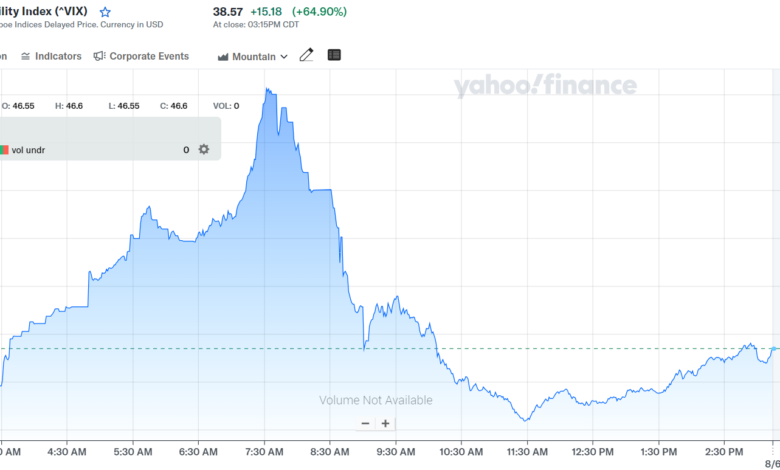Stock Market Shock: Dow Plummets Over 1,100 Points as Global Rout Hits S&P 500 and Nasdaq
In a dramatic turn of events, the stock market has experienced a severe downturn, with the Dow Jones Industrial Average plummeting by over 1,100 points. This significant decline has been mirrored by substantial losses in both the S&P 500 and Nasdaq indexes, highlighting a broader global financial rout. This article provides an in-depth analysis of the market shock, exploring the contributing factors and the potential consequences for investors and the global economy.

Market Overview: A Day of Turmoil
1. Dow Jones Plummets Over 1,100 Points
The Dow Jones Industrial Average, one of the most closely watched indicators of market performance, saw a staggering drop of more than 1,100 points in a single trading session. This unprecedented decline represents one of the most significant single-day losses in recent history, sending shockwaves through the financial world.
2. Declines in S&P 500 and Nasdaq
The S&P 500 and Nasdaq also experienced severe losses, reflecting the widespread nature of the market rout. The S&P 500, which tracks the performance of 500 large companies, fell sharply, while the Nasdaq Composite, heavily weighted towards technology stocks, also saw notable declines. The broad-based nature of the sell-off indicates a deep-seated issue affecting various sectors of the market.
3. Global Impact
The market turmoil is not confined to the United States. Global stock markets have been hit hard, with major indexes around the world experiencing significant drops. This global rout underscores the interconnectedness of financial markets and the ripple effects of economic and geopolitical events.
Factors Contributing to the Market Rout
1. Economic Uncertainty
Economic uncertainty has been a major driver of the recent market downturn. Concerns about slowing economic growth, rising inflation, and potential recession risks have led to increased volatility. Investors are reacting to a complex mix of economic indicators, including weaker-than-expected economic data and concerns over future monetary policy.
2. Geopolitical Tensions
Geopolitical tensions have also played a role in the market turmoil. Ongoing conflicts and diplomatic uncertainties have created a climate of instability, leading to heightened market fears. Geopolitical events can have far-reaching impacts on global trade and investment flows, contributing to overall market anxiety.
3. Corporate Earnings Reports
Recent corporate earnings reports have added to the market’s volatility. Some companies have reported disappointing earnings or provided weaker-than-expected forecasts, leading to declines in their stock prices. This has contributed to broader market declines as investors reassess their expectations for corporate profitability.
4. Interest Rate Concerns
Interest rate concerns are another significant factor influencing market behavior. The possibility of higher interest rates, driven by central banks’ responses to inflation, can impact borrowing costs and consumer spending. Higher rates can also lead to reduced corporate earnings and increased market volatility.
Implications for Investors
1. Portfolio Adjustments
In light of the recent market declines, investors may need to reassess their portfolios. Diversification and risk management strategies become crucial during periods of market turbulence. Investors should consider adjusting their asset allocations to mitigate potential losses and align with their long-term financial goals.
2. Investment Opportunities
While the current market environment presents challenges, it also offers potential investment opportunities. Market downturns can create buying opportunities for long-term investors who are willing to look beyond short-term volatility. Identifying undervalued assets and focusing on strong fundamental companies may provide growth potential in the recovery phase.
3. Emotional Impact
Market shocks can have an emotional impact on investors, leading to impulsive decisions driven by fear. It is essential for investors to remain focused on their long-term investment strategies and avoid making hasty decisions based on short-term market movements.
Looking Ahead: Market Outlook
1. Monitoring Economic Indicators
Investors and analysts will continue to monitor economic indicators for signs of stabilization or further decline. Key data points such as employment figures, inflation rates, and consumer confidence will provide insights into the health of the economy and potential market trends.
2. Policy Responses
Central banks and government policymakers may respond to the market turmoil with measures aimed at stabilizing the financial system. Interest rate adjustments, fiscal stimulus, and other policy actions could influence market dynamics and provide support to the economy.
3. Long-Term Trends
Despite the current volatility, long-term trends in the market and the economy will shape future performance. Investors should stay informed about evolving economic conditions and adjust their strategies accordingly to navigate the changing landscape.





